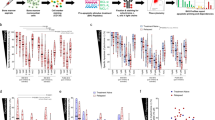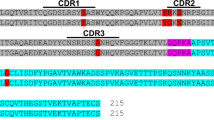Abstract
Treatment of light chain (LC) deposition diseases both nonfibrillar and fibrillar is aimed at eliminating LC production but success is limited. We report on the testing of an small interfering RNA pool targeting the κ LC constant region mRNA (si[IGKC]) designed for use against all κ plasma cell clones. To test for changes in κ LC message and protein production we used real-time PCR, immunoblot, intracellular mean fluorescence intensity and κ LC secretion by enzyme-linked immunosorbent assay. In vitro we employed 4 human cell lines that make κ LCs and 20 specimens of CD138-selected marrow plasma cells from patients with κ plasma cell diseases. In vivo, we used a murine flank plasmacytoma xenograft model. In vitro and in vivo, there were significant reductions in message and protein production by all modalities in all cell types despite diversity in variable region sequence. In addition, in clones producing intact immunoglobulin, caspase 3/7 activity with si[IGKC] was significantly increased compared with clones producing κ LC only, consistent with the triggering of a terminal unfolded protein response by excess unpaired heavy chains. In conclusion, si[IGKC] can significantly reduce κ LC production by κ plasma cells. Further preclinical development is needed to optimize delivery.
This is a preview of subscription content, access via your institution
Access options
Subscribe to this journal
Receive 12 print issues and online access
$259.00 per year
only $21.58 per issue
Buy this article
- Purchase on Springer Link
- Instant access to full article PDF
Prices may be subject to local taxes which are calculated during checkout



Similar content being viewed by others
References
Wechalekar AD, Offer M, Gillmore JD, Hawkins PN, Lachmann HJ . Cardiac amyloidosis, a monoclonal gammopathy and a potentially misleading mutation. Nat Clin Pract Cardiovasc Med 2009; 6: 128–133.
Merlini G, Wechalekar AD, Palladini G . Systemic light chain amyloidosis: an update for treating physicians. Blood 2013; 121: 5124–5130.
Gertz MA . Immunoglobulin light chain amyloidosis: 2013 update on diagnosis, prognosis, and treatment. Am J Hematol 2013; 88: 416–425.
Hassoun H, Flombaum C, D'Agati VD, Rafferty BT, Cohen A, Klimek VM et al. High-dose melphalan and auto-SCT in patients with monoclonal Ig deposition disease. Bone Marrow Transplant 2008; 42: 405–412.
Cohen AD, Comenzo RL . Systemic light-chain amyloidosis: advances in diagnosis, prognosis, and therapy. Hematology Am Soc Hematol Educ Program 2010; 2010: 287–294.
Palladini G, Comenzo RL . The challenge of systemic immunoglobulin light-chain amyloidosis (Al). Subcell Biochem 2012; 65: 609–642.
Nasr SH, Valeri AM, Cornell LD, Fidler ME, Sethi S, D'Agati VD et al. Renal monoclonal immunoglobulin deposition disease: a report of 64 patients from a single institution. Clin J Am Soc Nephrol 2012; 7: 231–239.
Weiss BM, Wong SW, Comenzo RL . Beyond the plasma cell: emerging therapies for immunoglobulin light chain amyloidosis. Blood 2016; 127: 2275–2280.
Hovey BM, Ward JE, Soo Hoo P, O'Hara CJ, Connors LH, Seldin DC . Preclinical development of siRNA therapeutics for AL amyloidosis. Gene Therapy 2011; 18: 1150–1156.
Phipps JE, Kestler DP, Foster JS, Kennel SJ, Donnell R, Weiss DT et al. Inhibition of pathologic immunoglobulin-free light chain production by small interfering RNA molecules. Exp Hematol 2010; 38: 1006–1013.
Ohno S, Yoshimoto M, Honda S, Miyachi S, Ishida T, Itoh F et al. The antisense approach in amyloid light chain amyloidosis: identification of monoclonal Ig and inhibition of its production by antisense oligonucleotides in in vitro and in vivo models. J Immunol 2002; 169: 4039–4045.
Zhou P, Ma X, Iyer L, Chaulagain C, Comenzo RL . One siRNA pool targeting the lambda constant region stops lambda light-chain production and causes terminal endoplasmic reticulum stress. Blood 2014; 123: 3440–3451.
Lefranc MP . IMGT (ImMunoGeneTics) locus on focus. A new section of Experimental and Clinical Immunogenetics. Exp Clin Immunogenet 1998; 15: 1–7.
Lefranc MP, Giudicelli V, Busin C, Bodmer J, Muller W, Bontrop R et al. IMGT, the International ImMunoGeneTics database. Nucleic Acids Res 1998; 26: 297–303.
Durie BG, Harousseau JL, Miguel JS, Blade J, Barlogie B, Anderson K et al. International uniform response criteria for multiple myeloma. Leukemia 2006; 20: 1467–1473.
Buxbaum J, Gallo G . Nonamyloidotic monoclonal immunoglobulin deposition disease. Light-chain, heavy-chain, and light- and heavy-chain deposition diseases. Hematol Oncol Clin North Am 1999; 13: 1235–1248.
Merlini G, Comenzo RL, Seldin DC, Wechalekar A, Gertz MA . Immunoglobulin light chain amyloidosis. Expert Rev Hematol 2014; 7: 143–156.
Klimtchuk ES, Gursky O, Patel RS, Laporte KL, Connors LH, Skinner M et al. The critical role of the constant region in thermal stability and aggregation of amyloidogenic immunoglobulin light chain. Biochemistry 2010; 49: 9848–9857.
Comenzo RL, Wally J, Kica G, Murray J, Ericsson T, Skinner M et al. Clonal immunoglobulin light chain variable region germline gene use in AL amyloidosis: association with dominant amyloid-related organ involvement and survival after stem cell transplantation. Br J Haematol 1999; 106: 744–751.
Comenzo RL, Zhang Y, Martinez C, Osman K, Herrera GA . The tropism of organ involvement in primary systemic amyloidosis: contributions of Ig V(L) germ line gene use and clonal plasma cell burden. Blood 2001; 98: 714–720.
Bodi K, Prokaeva T, Spencer B, Eberhard M, Connors LH, Seldin DC . AL-Base: a visual platform analysis tool for the study of amyloidogenic immunoglobulin light chain sequences. Amyloid 2009; 16: 1–8.
Zhou P, Comenzo RL, Olshen AB, Bonvini E, Koenig S, Maslak PG et al. CD32B is highly expressed on clonal plasma cells from patients with systemic light-chain amyloidosis and provides a target for monoclonal antibody-based therapy. Blood 2008; 111: 3403–3406.
Ahmann GJ, Chng WJ, Henderson KJ, Price-Troska TL, DeGoey RW, Timm MM et al. Effect of tissue shipping on plasma cell isolation, viability, and RNA integrity in the context of a centralized good laboratory practice-certified tissue banking facility. Cancer Epidemiol Biomarkers Prev 2008; 17: 666–673.
Kiyoi H, Naito K, Ohno R, Saito H, Naoe T . Characterization of the immunoglobulin light chain variable region gene expressed in multiple myeloma. Leukemia 1998; 12: 601–609.
Zhou P, Zhang Y, Martinez C, Kalakonda N, Nimer SD, Comenzo RL . Melphalan-mobilized blood stem cell components contain minimal clonotypic myeloma cell contamination. Blood 2003; 102: 477–479.
Denoroy L, Deret S, Aucouturier P . Overrepresentation of the V kappa IV subgroup in light chain deposition disease. Immunol Lett 1994; 42: 63–66.
Rocca A, Khamlichi AA, Touchard G, Mougenot B, Ronco P, Denoroy L et al. Sequences of V kappa L subgroup light chains in Fanconi's syndrome. Light chain V region gene usage restriction and peculiarities in myeloma-associated Fanconi's syndrome. J Immunol 1995; 155: 3245–3252.
Khamlichi AA, Rocca A, Touchard G, Aucouturier P, Preud'homme JL, Cogne M . Role of light chain variable region in myeloma with light chain deposition disease: evidence from an experimental model. Blood 1995; 86: 3655–3659.
Sun S, Wang M, Knupp SA, Soto-Feliciano Y, Hu X, Kaplan DL et al. Combinatorial library of lipidoids for in vitro DNA delivery. Bioconjug Chem 2012; 23: 135–140.
Wang M, Sun S, Alberti KA, Xu Q . A combinatorial library of unsaturated lipidoids for efficient intracellular gene delivery. ACS Synth Biol 2013; 1: 403–407.
Sun S, Wang M, Alberti KA, Choy A, Xu Q . DOPE facilitates quaternized lipidoids (QLDs) for in vitro DNA delivery. Nanomedicine 2014; 9: 849–854.
Wittrup A, Lieberman J . Knocking down disease: a progress report on siRNA therapeutics. Nat Rev Genet 2015; 16: 543–552.
Gazdar AF, Oie HK, Kirsch IR, Hollis GF . Establishment and characterization of a human plasma cell myeloma culture having a rearranged cellular myc proto-oncogene. Blood 1986; 67: 1542–1549.
Drewinko B, Mars W, Minowada J, Burk KH, Trujillo JM . ARH-77, an established human IgG-producing myeloma cell line. I. Morphology, B-cell phenotypic marker profile, and expression of Epstein-Barr virus. Cancer 1984; 54: 1883–1892.
Fahey JL, Buell DN, Sox HC . Proliferation and differentiation of lymphoid cells: studies with human lymphoid cell lines and immunoglobulin synthesis. Ann NY Acad Sci 1971; 190: 221–234.
Drexler HG, Dirks WG, MacLeod RA . False human hematopoietic cell lines: cross-contaminations and misinterpretations. Leukemia 1999; 13: 1601–1607.
Zhou P, Hoffman J, Landau H, Hassoun H, Iyer L, Comenzo RL . Clonal plasma cell pathophysiology and clinical features of disease are linked to clonal plasma cell expression of cyclin D1 in systemic light-chain amyloidosis. Clin Lymphoma Myeloma Leuk 2012; 12: 49–58.
Brito JL, Davies FE, Gonzalez D, Morgan GJ . Streptolysin-O reversible permeabilisation is an effective method to transfect siRNAs into myeloma cells. J Immunol Methods 2008; 333: 147–155.
Zhou P, Teruya-Feldstein J, Lu P, Fleisher M, Olshen A, Comenzo RL . Calreticulin expression in the clonal plasma cells of patients with systemic light-chain (AL-) amyloidosis is associated with response to high-dose melphalan. Blood 2008; 111: 549–557.
Acknowledgements
We thank the Division of Hematology-Oncology and Departments of Medicine and Pathology at Tufts for their continued support. We also acknowledge the continued support by the Amyloidosis and Myeloma Research Fund at Tufts, the Cam Neely and John Davis Myeloma Research Fund, the John C Davis Program for Myeloma and Amyloid at Tufts, the Sidewater Family Fund, the Lavonne Horowitz Trust, the Werner and Elaine Dannheiser Fund for Research on the Biology of Aging of the Lymphoma Foundation, Davis and Barbara Levine in memoriam and especially the Demarest Lloyd Jr Foundation for their continued commitment to ‘shutting down the factory’ in AL.
Author contributions
XM and PZ designed and performed experiments, analyzed data and wrote the manuscript; SWW, MW and CC obtained patient specimens and wrote the manuscript; RLC designed the research, analyzed data and wrote the manuscript.
Author information
Authors and Affiliations
Corresponding author
Ethics declarations
Competing interests
Drs Comenzo, Ma and Zhou have a patent pending on the siRNA sequences used to knock down expression of the κ light chain constant region. Dr Comenzo has served as a consultant or advisor to Takeda Millennium and Janssen, and has received clinical research funding from Takeda Millennium, Janssen, Teva and Prothena Biotech. Drs Wong and Chaulagain and Ms Warner declare no conflict of interest.
Rights and permissions
About this article
Cite this article
Ma, X., Zhou, P., Wong, S. et al. siRNA targeting the κ light chain constant region: preclinical testing of an approach to nonfibrillar and fibrillar light chain deposition diseases. Gene Ther 23, 727–733 (2016). https://doi.org/10.1038/gt.2016.50
Received:
Revised:
Accepted:
Published:
Issue Date:
DOI: https://doi.org/10.1038/gt.2016.50



